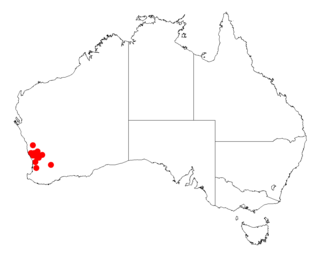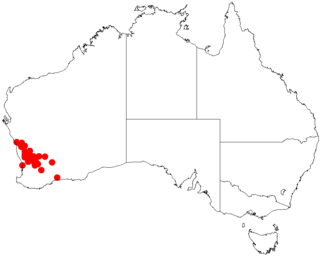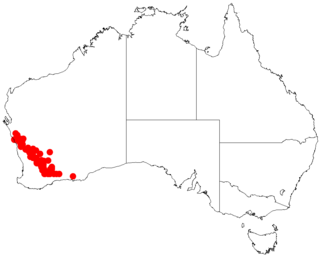
Acacia xiphophylla, commonly known as snakewood or snake-wood, is a tree in the family Fabaceae that is endemic to Western Australia. The indigenous group the Martuthunira, Ngarluma and Yindjibarndi peoples know it as marrawa, the Kariyarra know it as puluru and the Jiwarli know it as pukarti.

Acacia merinthophora, also known as zig-zag wattle, is a tree or shrub belonging to the genus Acacia and the subgenus Juliflorae that is endemic to western Australia.

Acacia trachycarpa, commonly known as minni ritchi, curly-bark tree, sweet-scented minni ritchi or Pilbara minni ritchi, is a shrub or tree belonging to the genus Acacia and the subgenus Juliflorae that is native to arid and semi-arid areas of Western Australia.

Acacia aestivalis is a shrub belonging to the genus Acacia and the subgenus Phyllodineae that is native to Western Australia.

Acacia calcarata is a shrub belonging to the genus Acacia and the subgenus Phyllodineae.

Acacia concolorans is a shrub belonging to the genus Acacia and the subgenus Phyllodineae that is endemic to Western Australia.

Acacia costata is a shrub belonging to the genus Acacia and the subgenus Phyllodineae that is endemic to Western Australia.

Acacia ericksoniae is a shrub belonging to the genus Acacia and the subgenus Phyllodineae that is native to Western Australia.

Acacia forrestiana, commonly known as Forrest's wattle, is a shrub belonging to the genus Acacia and the subgenus Phyllodineae that is native to Western Australia. The species was listed as vulnerable by the Environment Protection and Biodiversity Conservation Act 1999 in 2008.

Acacia retrorsa is a shrub of the genus Acacia and the subgenus Phyllodineae that is endemic to western Australia

Acacia scalena is a shrub of the genus Acacia and the subgenus Phyllodineae that is endemic to a small area in western Australia.

Acacia scleroclada is a shrub of the genus Acacia and the subgenus Phyllodineae that is endemic to an area of western Australia.

Acacia sphacelata is a shrub of the genus Acacia and the subgenus Phyllodineae that is endemic to south western Australia.
Acacia adnata is a shrub of the genus Acacia and the subgenus Plurinerves that is native to Western Australia.
Acacia amyctica is a shrub of the genus Acacia and the subgenus Plurinerves. It is native to an area in the south of the Goldfields-Esperance region of Western Australia.

Acacia colletioides, commonly known as wait-a-while, pin bush and spine bush, is a shrub of the genus Acacia and the subgenus Plurinerves that is native to Australia.

Acacia dielsii, commonly known as Diels' wattle, is a shrub of the genus Acacia and the subgenus Plurinerves that is native to Western Australia.
Acacia prismifolia is a shrub of the genus Acacia and the subgenus Plurinerves that is endemic to a small area of south western Australia. It was once thought to be extinct until a specimen was found in 2018.

Acacia subsessilis is a shrub of the genus Acacia and the subgenus Plurinerves that is endemic to an area of western Australia.

Acacia saxicola, commonly known as Mount Maroon wattle, is a shrub belonging to the genus Acacia and the subgenus Phyllodineae native to eastern Australia.

















